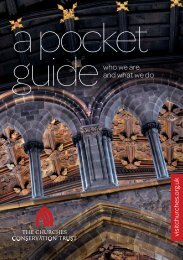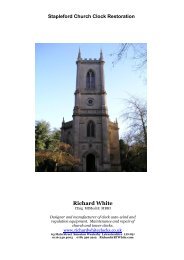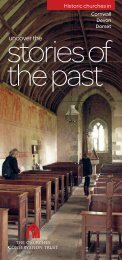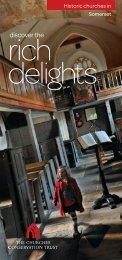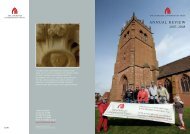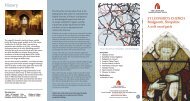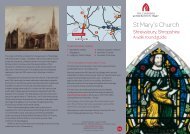All Souls Bolton Conservation Statement - The Churches ...
All Souls Bolton Conservation Statement - The Churches ...
All Souls Bolton Conservation Statement - The Churches ...
Create successful ePaper yourself
Turn your PDF publications into a flip-book with our unique Google optimized e-Paper software.
<strong>Bolton</strong>. It included the rebuilding of the parish church of St. Peter at <strong>Bolton</strong>, tothe designs of E.J.Paley. <strong>The</strong> cost of this (£40,000) was met by PeterOrmerod, a local cotton spinning magnate, and the new church wasconsecrated in 1871.St Peter’s was built before Paley entered into partnership with Hubert Austin.As Paley and Austin the architects were to design both <strong>All</strong> <strong>Souls</strong> church and itscompanion church of <strong>The</strong> Saviour, Deane Road (1882), both examples ofGreenhalgh munificence. <strong>The</strong> church of the Saviour was demolished in 1975.<strong>The</strong> new parish of <strong>All</strong> <strong>Souls</strong> was created in 1879 from part of that of StJames’s, Waterloo Street. A detail of the first edition Ordnance Survey map of1893, showing the church in its original context of terraced housing and mills,but with fields not far beyond, is attached at Appendix i. <strong>The</strong> parish continuedto grow well into the twentieth century. In 1935 a local newspaper reported:Whereas in 1875 there were but 875 houses and 4,522 persons in the parish[…], today there are some 8000 persons resident in this parish. Of these, it hasbeen ascertained that 2,401 claim allegiance to <strong>All</strong> <strong>Souls</strong>, 908 to other Churchof England parishes, 682 are Roman Catholics, and there are no Jews. 1However, the second half of the twentieth century witnessed the decline ofcotton manufacturing in <strong>Bolton</strong>, and demographic shifts brought about bylarge-scale immigration from the Indian sub-continent. In 1962 the parishwas re-united with that of St James’s, Waterloo Street when the latter churchwas closed. By 1986 it was estimated that 80% of the local population wasAsian and Muslim, and the numbers attending worship at <strong>All</strong> <strong>Souls</strong> haddeclined significantly. <strong>The</strong> diminishing congregation found it increasinglydifficult to worship in a large building designed to accommodate 800 millworkers, and to meet the growing repair and maintenance bills. It wastherefore decided that the church should close for regular worship. A reportprepared at the time by the Council for the Care of <strong>Churches</strong> (CCC) concluded:…in view of the sad loss about ten years ago of the companion to <strong>All</strong> <strong>Souls</strong>’, thechurch of <strong>The</strong> Saviour, it is vital that <strong>All</strong> <strong>Souls</strong> should be preserved […] Somealternative, use, for example for community purposes, might well suggest itselfin view of the great span of the interior without intervening arcades and pillars.Should an appropriate use not be forthcoming, the Council considers thechurch to be such an important example of the great town churches by Paleyand Austin that it ought to be preserved by the Redundant <strong>Churches</strong> Fund 2 .In the event no community use was forthcoming, and the building was vestedin the care of the Redundant <strong>Churches</strong> Fund (now the <strong>Churches</strong> <strong>Conservation</strong>Trust) in 1987. Since that time the church has been maintained by the CCTwith the help of local volunteers, and is opened to the public on an occasionalbasis. However it is underused, and prone to vandalism.1 <strong>Bolton</strong> Evening News 22 January 19352 CCC Report by Donald Findlay, 10 January 1986<strong>All</strong> <strong>Souls</strong>, <strong>Bolton</strong>: <strong>Statement</strong> of Significance 4





